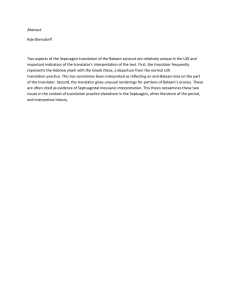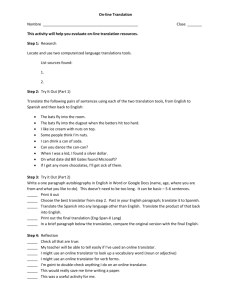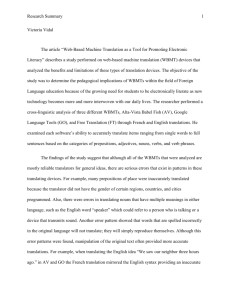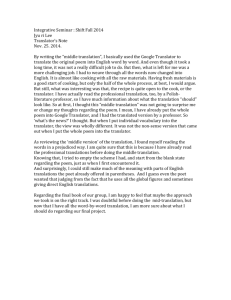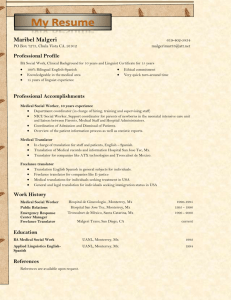Sample Test 4
advertisement
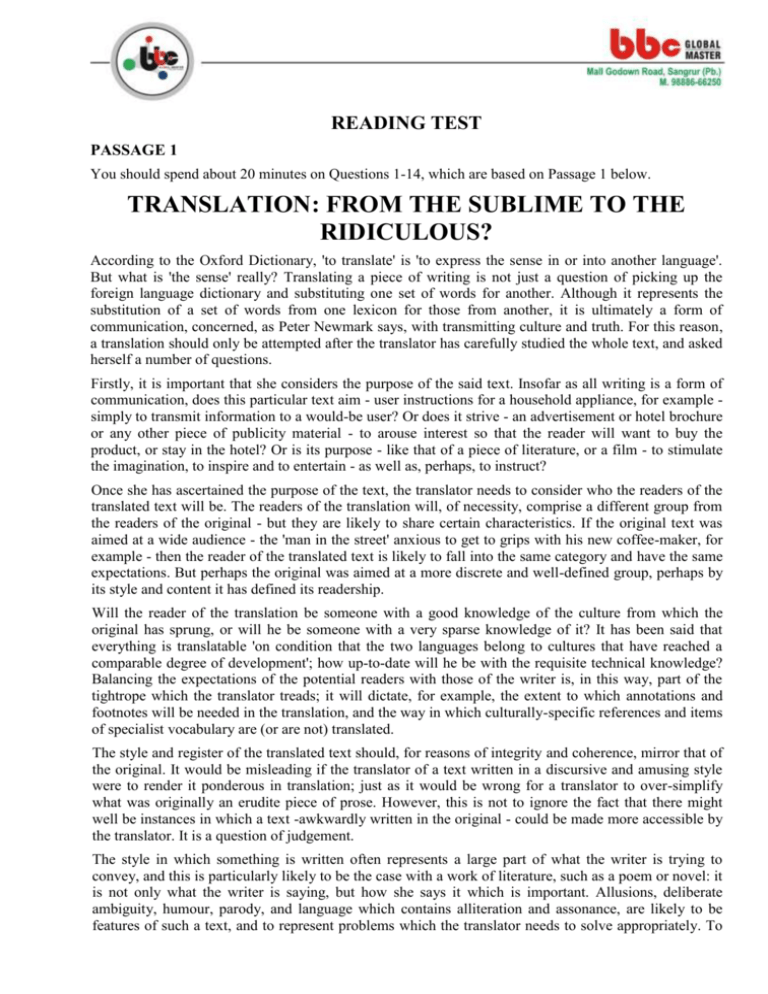
READING TEST PASSAGE 1 You should spend about 20 minutes on Questions 1-14, which are based on Passage 1 below. TRANSLATION: FROM THE SUBLIME TO THE RIDICULOUS? According to the Oxford Dictionary, 'to translate' is 'to express the sense in or into another language'. But what is 'the sense' really? Translating a piece of writing is not just a question of picking up the foreign language dictionary and substituting one set of words for another. Although it represents the substitution of a set of words from one lexicon for those from another, it is ultimately a form of communication, concerned, as Peter Newmark says, with transmitting culture and truth. For this reason, a translation should only be attempted after the translator has carefully studied the whole text, and asked herself a number of questions. Firstly, it is important that she considers the purpose of the said text. Insofar as all writing is a form of communication, does this particular text aim - user instructions for a household appliance, for example simply to transmit information to a would-be user? Or does it strive - an advertisement or hotel brochure or any other piece of publicity material - to arouse interest so that the reader will want to buy the product, or stay in the hotel? Or is its purpose - like that of a piece of literature, or a film - to stimulate the imagination, to inspire and to entertain - as well as, perhaps, to instruct? Once she has ascertained the purpose of the text, the translator needs to consider who the readers of the translated text will be. The readers of the translation will, of necessity, comprise a different group from the readers of the original - but they are likely to share certain characteristics. If the original text was aimed at a wide audience - the 'man in the street' anxious to get to grips with his new coffee-maker, for example - then the reader of the translated text is likely to fall into the same category and have the same expectations. But perhaps the original was aimed at a more discrete and well-defined group, perhaps by its style and content it has defined its readership. Will the reader of the translation be someone with a good knowledge of the culture from which the original has sprung, or will he be someone with a very sparse knowledge of it? It has been said that everything is translatable 'on condition that the two languages belong to cultures that have reached a comparable degree of development'; how up-to-date will he be with the requisite technical knowledge? Balancing the expectations of the potential readers with those of the writer is, in this way, part of the tightrope which the translator treads; it will dictate, for example, the extent to which annotations and footnotes will be needed in the translation, and the way in which culturally-specific references and items of specialist vocabulary are (or are not) translated. The style and register of the translated text should, for reasons of integrity and coherence, mirror that of the original. It would be misleading if the translator of a text written in a discursive and amusing style were to render it ponderous in translation; just as it would be wrong for a translator to over-simplify what was originally an erudite piece of prose. However, this is not to ignore the fact that there might well be instances in which a text -awkwardly written in the original - could be made more accessible by the translator. It is a question of judgement. The style in which something is written often represents a large part of what the writer is trying to convey, and this is particularly likely to be the case with a work of literature, such as a poem or novel: it is not only what the writer is saying, but how she says it which is important. Allusions, deliberate ambiguity, humour, parody, and language which contains alliteration and assonance, are likely to be features of such a text, and to represent problems which the translator needs to solve appropriately. To that extent, translating is rather like doing a jigsaw puzzle. Other kinds of writing - a piece of advertising, for example - may well contain subliminal messages to which the translator will need to be alert - as to any kind of' sub-text'. Much translation is, by default, given to those with an inadequate grasp of either the source or target language - and often of both. It is frequently overlooked that the successful translator needs an excellent knowledge of the source language and a perfect mastery of the target language in its technical and colloquial aspects. The target language, for the best results, should be her mother-tongue but, as Peter Newmark says, many translators who translate out of their own language 'contribute greatly to many people's hilarity in the process.' So, for example, it once happened that a sagesse normande' became, in English, 'Norman wisdom'. Question 1-3 Complete the sentences below with information from the reading passage. You may use NO MORE THAN THREE WORDS for each answer. 1 Translating a text is more than merely __________________ for others. 2 Each text whether informative, stimulating or instructive has ___________ that the translator needs to take into account. 3. The reader of the translation may have only a ________________ knowledge of the culture from which the original comes. Question 4-6 Choose the appropriate letters A-D and write them in Boxes 4-6 on your answer sheet. 4. Anything can be translated, provided that... A B C D the two languages are equally developed. the two languages have similar levels of cultural development. the translator is up-to-date. the translator has the same expectations as the reader. 5. According to the writer, it is sometimes possible to make a translation ... A B C D clearer than the original. overly simple. humorous. ponderous. 6. When translating a literary text, which one of the following is important for the translator? A B C D The way in which a writer says something as much as the content. Subliminal messages. Allusions. Jigsaw puzzles in texts. Question 7-10 The writer mentions a number of Judgements that need to be made by the translator. Which Four of the Judgements below are mentioned? Write your answers (A-H) in Boxes 7-10 on your answer sheet. 7. ________ 8. ________ 9. ________ 10. ________ List of Judgements A Weighing up why a writer says what she says. B Determining the importance of poetry. C Making a decision as to how far to stick to the original. D Judging who the target audience of a translation will be. E Whether translating is best done from the mother tongue. F Deciding how many explanations, footnotes and comments on vocabulary to include. G Deciding on which information to use from dictionaries. H Whether to oversimplify a text. Question 11-14 Answer the questions below using information from the passage. You may use NO MORE THAN THREE WORDS from the passage for each answer. Write your answers in Boxes 11-14 on your answer sheet. 11 Translation is a form of communication; what does it, in essence, transmit? 12 What do readers of a translation and readers of the original text often share? 13 Which aspects of the translated text should reflect the original? 14 What, according to the text, should a translator look at carefully before trying to do a translation?

